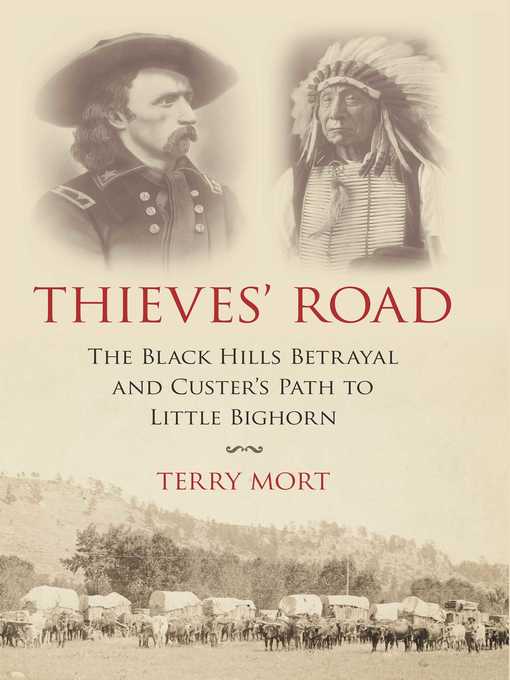
Thieves' Road
The Black Hills Betrayal and Custer's Path to Little Bighorn
کتاب های مرتبط
- اطلاعات
- نقد و بررسی
- دیدگاه کاربران
نقد و بررسی

December 15, 2014
Though much has been written about the legendary confrontation between the Lakota Sioux and Gen. George Custer’s U.S. cavalry at the 1876 Battle of the Little Bighorn, Mort (The Wrath of Cochise) examines Custer’s less well-known 1874 expedition to South Dakota’s Black Hills, in this dense work of narrative history. Custer’s goal was to discover if this region, little known to white Americans, held extensive gold deposits, and though he was careful not to exaggerate how much gold he found, word soon spread, drawing prospectors from across the nation. In Mort’s view, Custer’s discovery of gold made it inevitable that the federal government would try to gain control of the Black Hills by any means necessary, a decision that spelled the end of the Lakota Sioux’s way of life. Although Mort’s book suffers from occasional overwriting, it is a lively and impressively researched account not only of the collision between two very different ways of life, but between ideas about the ownership and use of land—a collision whose outcome would have long-lasting significance for both the victors and the vanquished, far beyond the remote hills of South Dakota. Agent: Don Fehr, Trident Media Group.

Starred review from November 15, 2014
The history of Gen. George Custer's 1,000-man exploration across 300 miles of Dakota Plains in search of gold.Mort's (The Wrath of Cochise, 2013, etc.) enlightening works about Native Americans are remarkable not only for their depth, but also for the poetic beauty of his descriptions of their lives, religions and cultures. The Sioux had no concept of private property. The land was theirs by right of conquest-of the Kiowa, Cheyenne and Crow-and due to the fact that they occupied it. The white man defined ownership as working the land-e.g., farming, which was work that male Indians felt was only for squaws. President Ulysses Grant's peace plan involved containing the tribes on reservations, training them in agriculture and taking their children into missionary schools. That was the best way to extinguish the Native American way of life, and the Sioux knew it was so. The stated objective of Custer's expedition in 1874 was to find a site for a permanent military installation, but the implicit goal was to find gold. It was hoped that the finding of gold in the Black Hills would help offset the country's massive Civil War debt. It would also bolster the stock and bonds tied to the Northern Pacific Railroad, an important project for the general. The Sioux called Custer's trail the Thieves' Road since it stole into their territory and foretold the end of their freedom and way of life. They had already dealt with incursion before, during the Red Cloud War, when Sioux, Cheyenne and Arapahoe joined to destroy the Bozeman Trail. The 1868 Treaty of Laramie closed forts along that trail and ceded a million acres with hunting rights outside the reservation. Mort's delightful prose will entice readers of history, geography, Native American studies and sociology. All will revel in the feeling of being in the Dakotas at the end of the 19th century.
COPYRIGHT(2014) Kirkus Reviews, ALL RIGHTS RESERVED.

January 1, 2015
Historian Mort (The Wrath of Cochise: The Bascom Affair and the Origins of the Apache Wars) turns his eye to Lieutenant Colonel George Armstrong Custer's 1874 expedition through the Black Hills in present-day South Dakota and Wyoming. Unlike Ernest Grafe and Paul Horsted's guidebook Exploring with Custer: The 1874 Black Hills Expedition, Mort concentrates on Custer's gold-seeking mission on the Great Sioux Reservation; lands that had been formally protected by the Treaty of Fort Laramie as being closed to gold prospectors. However, Custer's mission was a thinly veiled reconnaissance to find a suitable location for a new military fort. The author documents 19th-century American lust for the Black Hills as an encouraging factor in Custer's personal quest, and how Custer's reports of finding abundant gold served to turn public opinion further in his favor. Mort provides a legitimate historic viewpoint sympathetic to Native Americans, in which Custer is the spear point toward the Great Sioux War of 1876 (also called the Black Hills War) and its prominent action, the Battle of the Little Bighorn. VERDICT This highly readable and insightful work is recommended as an essential backstory to Custer's subsequent downfall at the aforementioned battle.--Nathan Bender, Albany Cty. P.L., Laramie, WY
Copyright 2015 Library Journal, LLC Used with permission.

























دیدگاه کاربران